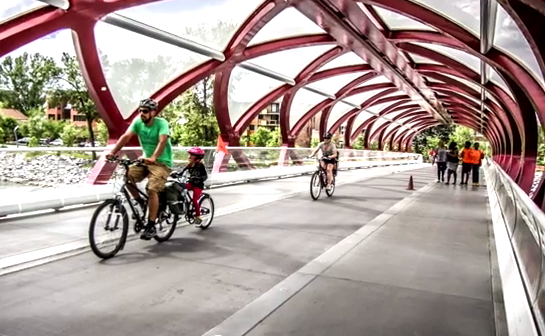• Flip Book • eNews • eAdventures • eCities • eBikeTypes • eRoad • eMTB • eUrban • eCargo • eBikeTests •
Cycling Cities on the Move – Calgary, Alberta
October 29, 2021 - Population 1.16 million – Boasting the largest network in North America, Calgary’s Pathways feature over 1,000km of paved off-street urban multi-use routes along with 96km of trails, plus an additional 423km of on-street bicycle routes.

Ranked 5th in the University of British Columbia’s most bike-friendly cities in Canada, Calgary approved a Cycling Strategy in 2011 with 50 activations to achieve its vision, including the goal to build 30km of separated bike lanes by 2020 along with 180km of additional bikeways.
The 6.5km Cycle Track pilot project for separated bike lanes in the city centre, which launched in June 2015, was a huge success. The pilot project led to a 40% increase in ridership and became permanent in 2016. While budget constraints have slowed progress, the city now has 12km of separated bike lanes and 68km of new bikeways.

The pandemic saw increases of primarily recreational ridership, and Calgary continues to make headway to achieve its goals with new Adaptive Roadways underway.
According to the City, before the pandemic, approximately 14,000 residents commuted to work daily, and an average of 35,000 Calgarians were riding a bike every day. A total of 580,000 people reported using a bike in 2020 with 146,000 using a bike at least once per week.
Bike Calgary, the city’s main cycling advocacy group, hosts several events such as Bike to Work Day and the Cyclepalooza bicycle festival, while Sustainable Calgary advocates for active transportation for a sustainable future.
The City saw success with e-bike and e-scooter share pilots and recently selected Neuron Mobility and Bird Canada as partners.
Safer streets is another concern; in February 2021, the City lowered the default speed limit in residential neighbourhoods from 50kph to 40kph with a goal to reach 30kph, the worldwide benchmark.
Calgary’s Barley Belt, where the beer industry is booming, has seen $5.5 million towards active transportation as part of a larger capital spending package.
Known for its frigid, snowy winters, Calgary has a mandate to clear about 500km of pathways within 24 hours of a snowfall ending. With a climate similar to Stockholm’s, where ridership is 10%, Calgary is a cycling city on the move to achieve a high ranking.






